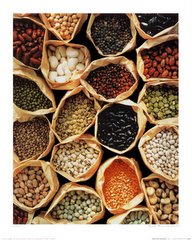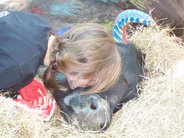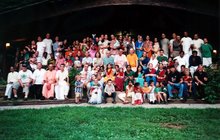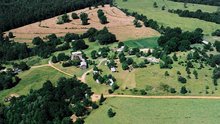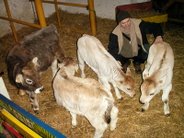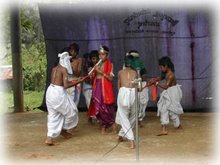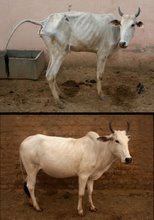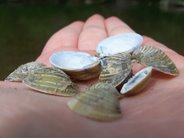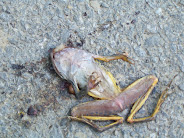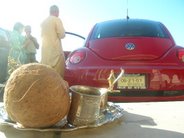Friday, April 20, 2007
City Life/Village Life- A Brief Video Juxstaposition
A beautiful short film by Ekendra Prabhu.
http://www.youtube.com/watch?v=gLPPu3r9iMU
http://www.youtube.com/watch?v=gLPPu3r9iMU
Sunday, April 15, 2007
What's in Your Milk? An Expose on the DANGERS of Genetically Engineered Milk
 By Samuel S. Epstein, M.D.
By Samuel S. Epstein, M.D.Cancer Prevention Coalition, January 3, 2007
Straight to the Source
CHICAGO, Illinois, --/WORLD-WIRE/-- Dr. Samuel S. Epstein, professor emeritus of environmental medicine at the University of Illinois at Chicago School of Public Health and world renowned author, has announced the publication of his new book, "What's in Your Milk?", a powerful expose of the dangers of Monsanto's genetically engineered (rBGH) milk, and the company's no-holds-barred conspiracy to suppress this information.
rBGH (recombinant Bovine Growth Hormone) is a genetically engineered, potent variant of the natural growth hormone produced by cows. Manufactured by Monsanto, it is sold to dairy farmers under the trade name POSILAC. Injection of this hormone forces cows to increase their milk production by about 10%. Monsanto has stated that about one third of dairy cows are in herds where the hormone is used.
Monsanto, supported by the Food and Drug Administration (FDA), insist that rBGH milk is indistinguishable from natural milk, and that it is safe for consumers. This is blatantly false: rBGH makes cows sick. Monsanto has been forced to admit to about 20 toxic effects, including mastitis, on its Posilac label.
*rBGH milk is contaminated by pus, due to the mastitis commonly induced by rBGH, and antibiotics used to treat the mastitis. *rBGH milk is chemically, and nutritionally different than natural milk. *Milk from cows injected with rBGH is contaminated with the hormone, traces of which are absorbed through the gut into the blood. *rBGH milk is supercharged with high levels of a natural growth factor (IGF-1), which is readily absorbed through the gut. *Excess levels of IGF-1 have been incriminated as a cause of breast, colon, and prostate cancers. IGF-1 blocks natural defense mechanisms against early submicroscopic cancers. *rBGH factory farms pose a major threat to the viability of small dairy farms. *rBGH enriches Monsanto, while posing dangers, without any benefits, to consumers, especially in view of the current national surplus of milk.
Article continued at http://www.organicconsumers.org/articles/article_3717.cfm
rBGH (recombinant Bovine Growth Hormone) is a genetically engineered, potent variant of the natural growth hormone produced by cows. Manufactured by Monsanto, it is sold to dairy farmers under the trade name POSILAC. Injection of this hormone forces cows to increase their milk production by about 10%. Monsanto has stated that about one third of dairy cows are in herds where the hormone is used.
Monsanto, supported by the Food and Drug Administration (FDA), insist that rBGH milk is indistinguishable from natural milk, and that it is safe for consumers. This is blatantly false: rBGH makes cows sick. Monsanto has been forced to admit to about 20 toxic effects, including mastitis, on its Posilac label.
*rBGH milk is contaminated by pus, due to the mastitis commonly induced by rBGH, and antibiotics used to treat the mastitis. *rBGH milk is chemically, and nutritionally different than natural milk. *Milk from cows injected with rBGH is contaminated with the hormone, traces of which are absorbed through the gut into the blood. *rBGH milk is supercharged with high levels of a natural growth factor (IGF-1), which is readily absorbed through the gut. *Excess levels of IGF-1 have been incriminated as a cause of breast, colon, and prostate cancers. IGF-1 blocks natural defense mechanisms against early submicroscopic cancers. *rBGH factory farms pose a major threat to the viability of small dairy farms. *rBGH enriches Monsanto, while posing dangers, without any benefits, to consumers, especially in view of the current national surplus of milk.
Article continued at http://www.organicconsumers.org/articles/article_3717.cfm
Know the Source of Your Supplements
The following website contains biological and nutritional information on the origin of Vitamin D supplements. This is a must read for strict vegetarians.
http://vitamind.ucr.edu/milk.html
http://vitamind.ucr.edu/milk.html
Friday, April 13, 2007
US Faces Change as Climate Warms
By EDITH M. LEDERER -- Associated Press Writer
Tuesday, April 10th, 2007 06:52 PM (PDT) | |
These are some of the findings about North America in a report by hundreds of scientists that try to explain how global warming is changing life on Earth. The scientists with the Intergovernmental Panel on Climate Change released a summary of their findings on global warming last Friday and outlined details of the report focusing on various regions on Tuesday.
According to the panel, global warming is already having an effect on daily life but when the Earth gets a few degrees hotter, the current inconvenience could give way to danger and even death. The North American impact will be felt from Florida and Texas to Alaska and Canada's Northwest Territories.
"Canada and the United States are, despite being strong economies with the financial power to cope, facing many of the same impacts that are projected for the rest of the world," Achim Steiner, executive director of the U.N. Environment Program which co-founded the panel, said in a statement.
He said the findings underline that the best way to reduce the effects of global warming is "deep and decisive cuts in greenhouse gas emissions to avoid dangerous climate change in the first place."
The panel warned that shifts in rainfall patterns, melting glaciers, rising temperatures, increased demand and reduced supplies of water in some places are likely to increase tensions between users - industry, agriculture and a growing population.
"Heavily-utilized water systems of the western U.S. and Canada, such as the Columbia River, that rely on capturing snowmelt runoff, will be especially vulnerable," the report said.
A temperature warming of a few degrees by the 2040s is likely to sharply reduce summer flows, at a time of rising demand, it said.
By then, the panel estimated that Portland, Oregon, will require over 26 million additional cubic meters of water as a result of climate change and population growth, but the Columbia River's summer supply will have dropped by an estimated 5 million cubic meters.
Meanwhile, it said, just over 40 percent of the water supply to southern California is likely to be vulnerable by the 2020s due to losses of the Sierra Nevada and Colorado River basin snow packs.
The panel also said "lower levels in the Great Lakes are likely to influence many sectors" and exacerbate controversies over diverting water to cities such as Chicago, and the competing demands of water quality, lake-based transport, and drought mitigation.
Cities could also be at risk from high tides and storm surges, it said.
http://www.thenewstribune.com/24hour/nation/story/3596211p-12867564c.html
Wednesday, April 11, 2007
Cow Power
By Bruce Edwards Rutland Herald
CVPS Cow Power, which turns manure into energy, and Blue Spruce Farm in Bridport were the recipients of the state's highest environmental award. The award recognized Cow Power's benefits of improved air and water quality, reduced greenhouse gases and generating renewable energy.
The award was presented by Gov. James Douglas to Cow Power coordinator David Dunn and Marie Audet of Blue Spruce Farm, the first dairy farm in CV's service territory to produce electricity from manure.
"Through their partnership, the Audet family and Central Vermont Public Service have given new economic hope to many of our Vermont farms while providing customers a fully renewable energy choice," Douglas said in presenting the award at a Statehouse ceremony. "In creating CVPS Cow Power, the company built an entirely new economic and environmental model for manure management, and the Audets were brave enough to become pioneers and prove that it would work."
http://www.timesargus.com/apps/pbcs.dll/article?AID=/20070130/NEWS02/701300323/1003/NEWS02
A highly touted renewable energy program created by Central Vermont Public Service Corp. was honored Monday with the Vermont Governor's Award for Environmental Excellence.
CVPS Cow Power, which turns manure into energy, and Blue Spruce Farm in Bridport were the recipients of the state's highest environmental award. The award recognized Cow Power's benefits of improved air and water quality, reduced greenhouse gases and generating renewable energy.
The award was presented by Gov. James Douglas to Cow Power coordinator David Dunn and Marie Audet of Blue Spruce Farm, the first dairy farm in CV's service territory to produce electricity from manure.
"Through their partnership, the Audet family and Central Vermont Public Service have given new economic hope to many of our Vermont farms while providing customers a fully renewable energy choice," Douglas said in presenting the award at a Statehouse ceremony. "In creating CVPS Cow Power, the company built an entirely new economic and environmental model for manure management, and the Audets were brave enough to become pioneers and prove that it would work."
http://www.timesargus.com/apps/pbcs.dll/article?AID=/20070130/NEWS02/701300323/1003/NEWS02
Friday, April 6, 2007
Hungary Cows gone Hungry?
Video clip of cows in Hungary's ISKCON cow protection program in full
ecstasy after being set out to pasture for the first time this year.
http://smileofkrishna.com/?p=40
Wednesday, April 4, 2007
Australian Devotee Performs Unusual Service For Snake and Man
George The Snakeman by Ekendra Prabhu
Here in New Govardhana our presiding deities are Their Beautiful Lordships Sri Sri Radha-Govardhandhari, Krishna-Balarama and Gaura-Nitai. As a community we try to please them with our offerings of devotion and nearly everyone here feels as if they have a personal relationship with Them through service. Sometimes Their reciprocation is clearly demonstrated for all of us to see and thus increase our faith and love. Here is a little story that shows Their love for one devotee in our community.Monday, April 2, 2007
Climate Change
Interactive MSNBC news report
 | • The greenhouse effect How the Earth maintains a temperature conducive to life |
 | • Cooling the planet Check out five far-out ideas on how to engineer a cooler Earth. |
 | • Eyeing the ice The National Science Foundation's Tom Wagner explains why climate experts are eyeing Antarctica. |
 | • Capturing CO2 A look at carbon sequestration |
 | • Melting mountains Data shows five areas of concern |
 Wieck | • Greenest and meanest vehicles 2007 vehicle models by their “green scores.” |
 | • Energy map of America A look at where the nation gets its energy |
http://www.msnbc.msn.com/id/17802540/from/ET/
Living Within the Ecosystem
Compiled by Umapati Swami from articles by Kamra Devi Dasi
and Vyapaka Dasa
MANY FARMERS are beginning to wonder whether it makes any
sense to farm atall. With the price of inputs -- fertilizers, pesticides,
herbicides -- going up continually and market forces pushing the
price of crops lower and lower, year after year, it seems that profit
can only be found in government subsidy programs.
But nature has been offering a solution all along, and ox power
plays an important part in it.
The solution?
Farming within nature's own ecosystems.
An ecosystem is a grouping of plants, animals, and microbes interacting
with each other and their environment in such a way that the grouping
perpetuates itself.
An ecosystem is by definition self-sufficient. It is a kind of circle
turning on energy provided by the sun: each living entity in the system
acquires food and produces waste, which becomes food for the next living
entity along the ecological feeding trail. In this way the nutrients move
through a large, diverse population of mammals, insects, bacteria, plants,
and others until they return to their point of origin and start again.
The industrial farmer finds himself dependent on a constant supply of
agricultural inputs. His nitrogen fertility, for example, comes at great
expense from a distant petrochemical plant that ships its wares across
the country by an energy-intensive transport system.
The same nitrogen could be produced effortlessly and economically by
bacteria at the roots of a legume. Being a cash cropper, however, the
farmer finds it financially difficult to leave any land fallow and planted
to a grass legume.
In a cash-cropping operation, a monoculture or very limited rotation is
generally the rule. Oxen, however, force the farmer to live within the
ecosystem because they demand a more diverse crop rotation, including
hay, pasture, and small grains -- a production more conservation-oriented
than the extended back-to-back annual production of row crops.
Since the different kinds of plants do not share pests, the risk of pest
populations building up is reduced because the pests' food source is
restricted. The farmer can thus eliminate the use of pesticides and allow
the reestablishment of balanced pest predator populations, providing
further ecological balance.
As the rotation is established, the mixing of plant cultures, coupled with
improved and timely tillage, checks the growth of weeds. The farmer can
eliminate herbicides, another costly input.
The design and careful implementation of a well-balanced rotation, combined
with the recycling of nutrients around the farm through the application of
composted cow and ox manure, can reduce or abolish the import of inorganic
fertilizers.
It is estimated that seventy-five percent of the nutrients found in the
feed ends up in the animals' waste. Through the use of compost, the farmer
can divert stocks of nitrogen, phosphorus, and potassium from pasture and
hay fields onto grain fields, where they are more needed. The increased
recycling potential of the farm results in lower costs through
self-sufficiency.
When animal waste is returned to the soil, its high nitrogen content makes
it a good fertilizer. If it is unreturned -- dumped into a water supply,
for instance -- much of its nitrogen turns into ammonia and nitrates.
The dumping of animal waste into water -- a common practice among
commercial dairies -- can pollute rural wells and even city water supplies
with nitrates. Last year the Florida Department of Environmental
Regulation found high nitrate levels in the ground water at nine dairies.
An excessive intake of nitrates can be dangerous, causing brain damage and
death to infants and health problems in the elderly.
Cow manure is the best of natural fertilizers and stabilizers of soil
structure. The Hoosefield experiment in Rothamsted, England, showed that
applications of cow manure over a period of twenty years resulted in more
soil humus and higher barley yields even fifty years after the
applications had been discontinued.
In 1974 Bronner and Janick studied 154 Austrian farms growing sugar beets.
On the sixty-five farms that had cows, the humus content of the soil was
20.2 percent higher than on the others, the humic acids were 21 percent
higher, and the soil structure was more stable by 13 percent.
The farms with cows needed 53 percent less fertilizer application of
nitrogen, 39 percent less of phosphorus, and 32 percent less of potassium.
Cow manure can also be put into tanks to generate methane gas for cooking
and heating, and the residue can be used as fertilizer. Yet today's
industrial society goes to great lengths to import petroleum-based fuel
while running its local supplies of fuel into rivers and water supplies as
a pollutant.
http://www.umapati.net/
Subscribe to:
Posts (Atom)

